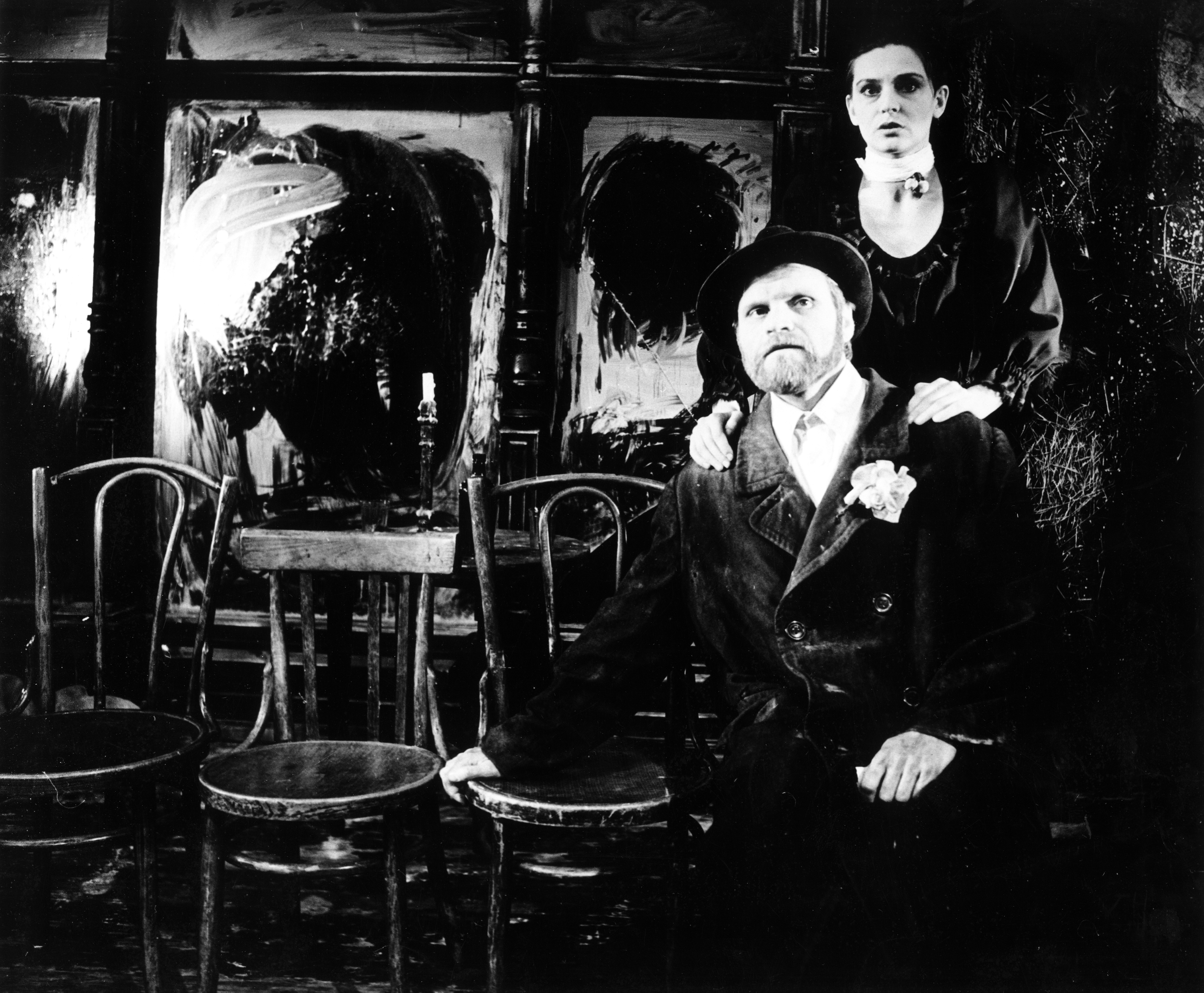As theatre critic Egmontas Jansonas wrote in 1984, Eimuntas Nekrošius’ plays were not “models of the world, but the world itself: with all of its relationships, colors, sounds, aromas, dramas, tragedies – past and future.” Egmontas Jansonas, „Kiekvienas žmogus – žemės dalis“, Vakarinės naujienos, 1984-02-27, p. 2.
Nekrošius first appeared on the Lithuanian stage scene in 1977 with his production at the State Youth Theatre of Shelagh Delaney’s play A Taste of Honey. However he truly displayed his abilities to create “the world itself” on stage in 1980 when, after a brief interlude of creative activity in Kaunas (staging Saulius Šaltenis’ Duokiškio baladės (The Ballads of Duokiškis) in 1978 and Anton Chekhov’s Ivanov that same year), he returned to his “native” Youth Theatre and – after a “warm-up” production of Katė už durų (The Cat Behind the Door, 1980) by Šaltenis and Grigorijus Kanovičius – he stunned audiences with Kvadratas (The Square) (text by Saulius Šaltenis, set design by Adomas Jacovkis, composition by Faustas Latėnas).
|
See also: Saulius Šaltenis.
|
The Youth Theatre was “home” for Nekrošius primarily because that is where his theatrical “family” also worked: his acting studies classmates from the Lithuanian State Conservatory (the famous “group of ten”) and, most importantly, senior director Dalia Tamulevičiūtė, Nekrošius’ first instructor in the craft. She had unselfishly handed Nekrošius over to her directing instructor colleagues in 1977, and now she was prepared, again not thinking about herself, to surrender to him the all-important title of director and even grant him exclusive artistic privileges, to “let him work peacefully and to be here to ensure that he have that peace”, as she herself told the German theatre critic Georg Menchen in 1984. Georgas Menchenas, „Pas mus nėra žvaigždžių“, Literatūra ir menas, 1984-06-16, p. 13.
Nothing seemingly groundbreaking was promised by the decision to stage Kvadratas. “Just another average holiday was coming up,” Эгмонт Янсонас, „Эймунт Някрошюс: Как мы будeм выглядеть лет через сто“, Литературная газета, 1988-05-18, p. 8. recalled Nekrošius in 1988, “and we had a few months to mount a Soviet play, and there was nothing interesting left,” so they had to settle for an almost unknown documentary story by Valentina Yeliseyeva called It Was Like This…, a simple, somewhat sentimental love story between a prisoner and his teacher.
On stage, however, the story unexpectedly resounded completely differently than on the page. In the cramped space of Kvadratas, roughly framed by four posts, His (Kostas Smoriginas) one-man cell was the setting of a scene of shocking severity and an attempt to survive arising not so much from Yesilyeva’s story, but rather from the “barely suppressible desire, hanging in the air, to testify about trampled dignity, distorted existence and the lost space of personal freedom.” Ramunė Marcinkevičiūtė, Eimuntas Nekrošius: erdvė už žodžių, Vilnius: Scena, Kultūros barai, 2002, p. 88.
Having addressed this need more forcefully than any other production at the time, Kvadratas was the first instance in Lithuanian theatre history of a play, staged on the basis of secondary material, surpassing productions that interpreted works of great literature. It was an unequivocal triumph at the Lithuanian theatre festival in 1981 held to commemorate the 26th Congress of the Soviet Communist Party, and it became legend.
Kvadratas had truly powerful competitors. It was staged almost simultaneously with Jonas Vaitkus’ production of Šarūnas (1980) that rocked the Kaunas Drama Theatre, and with Saulius Varnas’ production in Šiauliai of Georg Büchner’s Woyzeck, also in 1980.
Nekrošius kept his distance from great literature for a little while longer after Kvadratas. In this way, he was furthest from Saulius Varnas who, at the start of the 1980s, had already directed: Santa Cruz by Max Frisch in 1977, Death of Tarelkin by Aleksandr Sukhovo-Kobylin in 1979, Edvard Radzinsky’s Lunin, or the Death of Jacques in 1980, and Büchner’s Woyzeck in 1980, among others. In one discussion about Varnas’ theatre in 1981, however, Nekrošius spoke very charmingly about how he differed from Varnas: “Saulius Varnas’ direction reminds me of an inexperienced pianist tackling a very complicated piece of music. That is why his plays – global in their ideas and concepts – appear forced, skipping over the most elementary, basic but essential fundamentals”. „Repertuaras, režisierius, aktorius“, Literatūra ir menas, 1981-10-24, p. 7.
Kvadratas stunned the Lithuanian theatrical community first and foremost with its innovative directorial concept. Nekrošius demonstrated the full breadth of the range of meaning and what powerful emotional effect can be achieved when directing liberates the immense space that exists beyond the written word, when it is mastered by an individual’s theatrical imagination and imbued with human experiences and is expressed in independent stage imagery, through an actor’s physicality and through the unexpected relationships between objects, sounds and gestures that legitimize the uniqueness of theatrical language.
This concept of directing was most unforgettably demonstrated in Kvadratas during the famous sugar scene. In it, She (played by Dalia Overaitė, Janina Matekonytė) visits Him in prison, where He gives Her, one after another, all the pieces of sugar he has saved during their 1,002 days of separation, seemingly exposing his soul in an ever-intensifying rain of silence, testifying to the enormity of his loneliness, longing, shyness, hope, and his expectations of freedom and love. Nekrošius turned a simple piece of sugar into an incredibly expansive stage image and “forced” it to express what words alone would only demean.




Comments
Write a comment